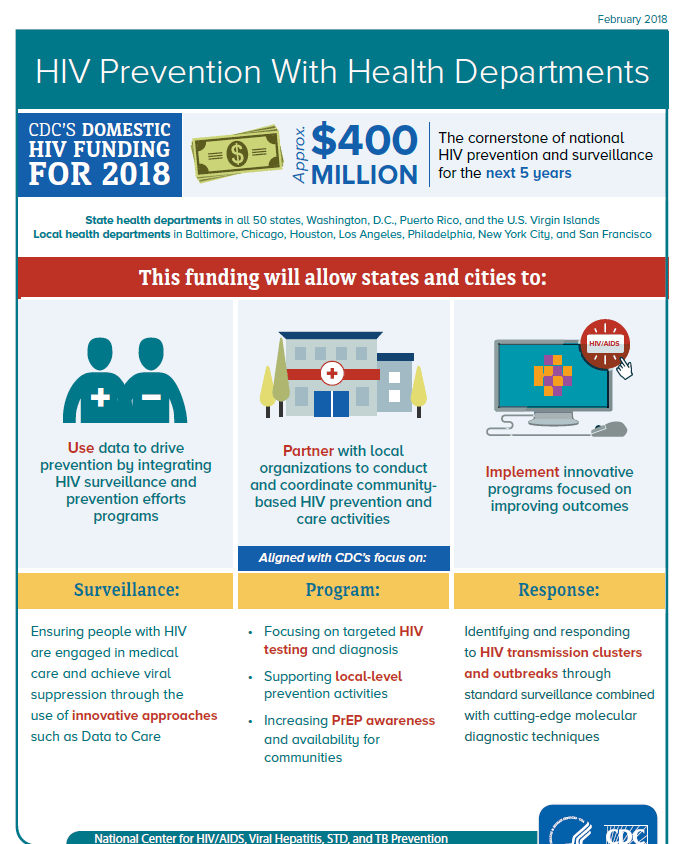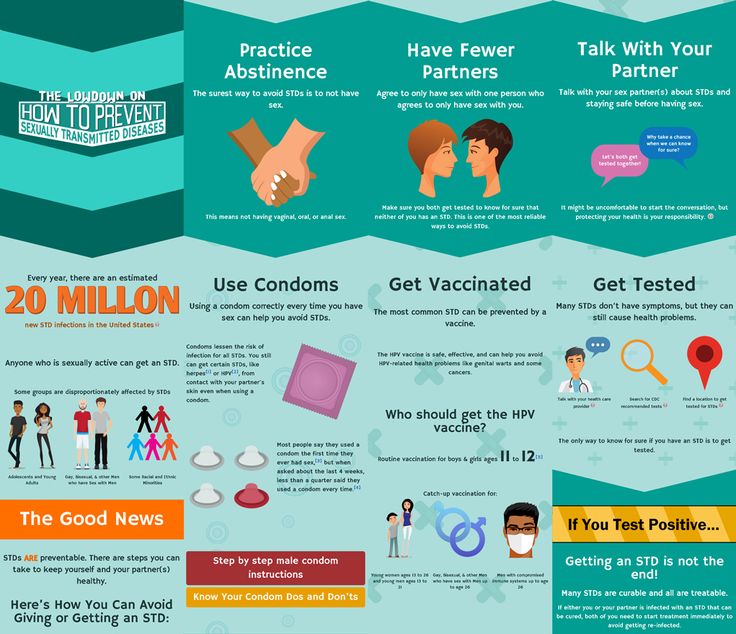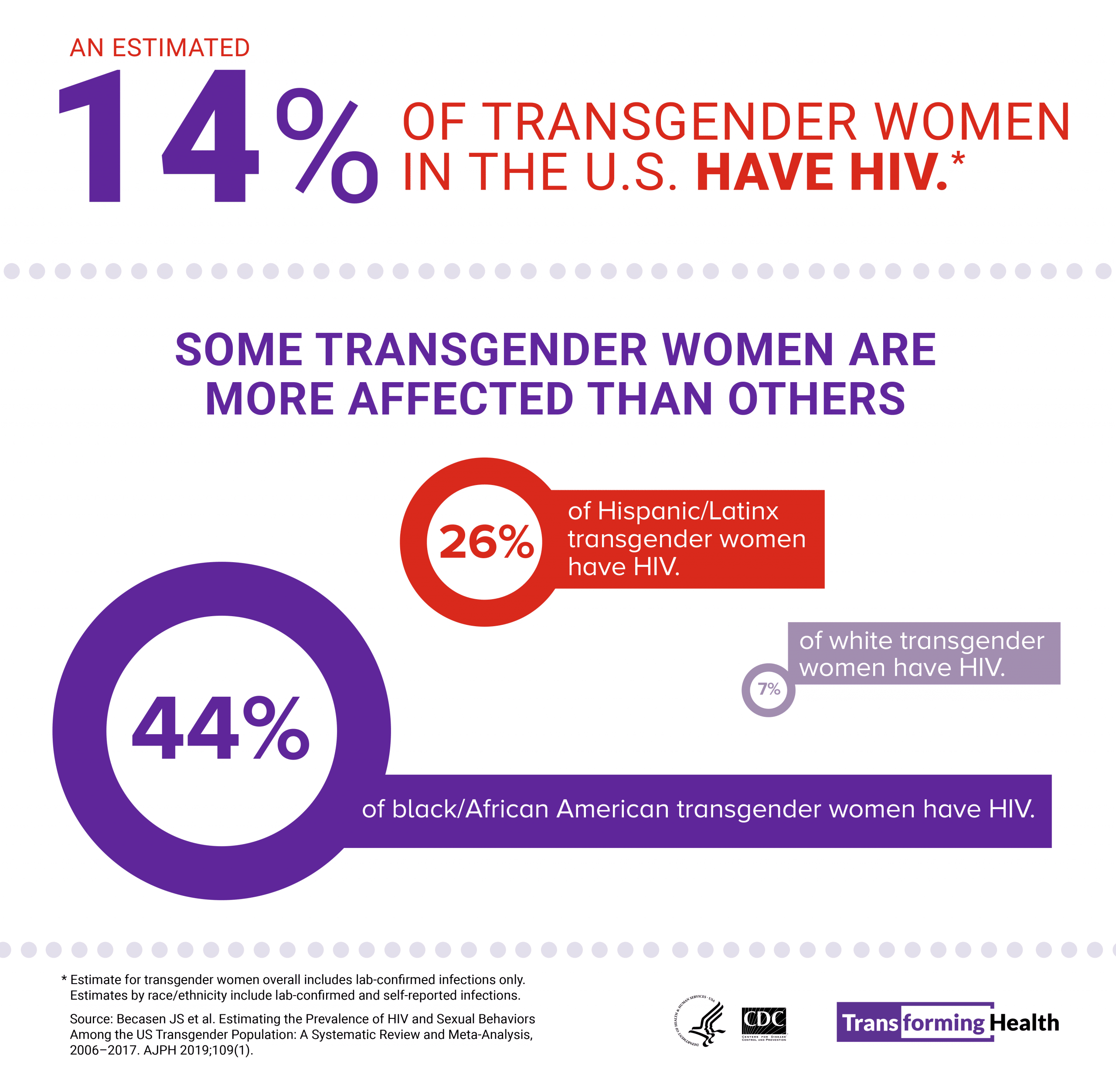How Can Pelvic Inflammatory Disease Be Prevented
Latex condoms may reduce the risk of PID by preventing STDs. Since STDs play a major role in PID, screening of women at risk for infection and treatment of infected women and their sex partners can help to minimize the risk of PID. Screening of young sexually active women for chlamydia has been shown to decrease the incidence of PID.28, 29
The United States Preventive Services Task Force recommends annual chlamydia and gonorrhea screening in women younger than 25 years25 and CDC recommends that providers screen the following populations for chlamydia and gonorrhea: all sexually active women younger than 25 years, as well as older women with risk factors such as new or multiple sex partners, or a sex partner who has a sexually transmitted infection.
How Can A Person Reduce The Risk Of Getting An Std
Sexual abstinence is the only way to eliminate any chance of getting an STD. But if you are sexually active, you can take the following steps to lower your risk for STDs, including HIV.
Choose less risky sexual behaviors.
- Reduce the number of people you have sex with.
- Do not drink alcohol or use drugs before and during sex.
Use condoms correctly every time you have sex.
- Visit this website from the Centers for Disease Control and Prevention to learn how to use condoms correctly.
What Is The Economic Burden Of Pelvic Inflammatory Disease In The United States
A decline in incidence of PID is also reflected in the most recent cost estimates of PID and its sequelae. Direct medical expenditures for PID and its sequelae were estimated at $1.88 billion in 1998,30 compared to approximately $2.7 billion estimated in 1990.31 Based on NHANES 20132014 data, an estimated 2.5 million women aged 1844 years in the United States reported a lifetime history of PID diagnosis,18 with each case of PID having an estimated cost of $3,202 .32
You May Like: Can You Give Yourself Aids
What Is The Connection Between Hiv And Other Stds
Behaviors that put people at risk for HIV also increase their risk for other STDs. These behaviors include the following:
- Having sex without a condom.
- Having sex with many partners, especially anonymous partners.
- Having sex while using drugs or alcohol. Using drugs and alcohol can affect a person’s judgement, which can lead to risky behaviors.
Having an STD can make it easier to get HIV. For example, an STD can cause a sore or a break in the skin, which can make it easier for HIV to enter the body. Having HIV and another STD may increase the risk of HIV transmission.
How Can A Person With Hiv Prevent Passing Hiv To Others

Take HIV medicines daily. Treatment with HIV medicines helps people with HIV live longer, healthier lives. One of the goals of ART is to reduce a person’s viral load to an undetectable level. An undetectable viral load means that the level of HIV in the blood is too low to be detected by a viral load test. People with HIV who maintain an undetectable viral load have effectively no risk of transmitting HIV to their HIV-negative partner through sex.
If your viral load is not undetectableor does not stay undetectableyou can still protect your partner from HIV by using condoms and choosing less risky sexual behaviors. Your partner can take medicine to prevent getting HIV, which is called pre-exposure prophylaxis . PrEP is an HIV prevention option for people who do not have HIV but who are at risk of getting HIV. PrEP involves taking a specific HIV medicine every day to reduce the risk of getting HIV through sex or injection drug use.
To learn more, read the HIVinfo Pre-Exposure Prophylaxis fact sheet.
Don’t Miss: Can Straight People Get Hiv
What Is The Treatment For Stds
STDs caused by bacteria or parasites can be cured with medicine. There is no cure for STDs caused by viruses, but treatment can relieve or eliminate symptoms and help keep the STD under control. Treatment also reduces the risk of passing on the STD to a partner. For example, although there is no cure for HIV, HIV medicines can prevent HIV from advancing to AIDS and reduce the risk of HIV transmission.
Untreated STDs may lead to serious complications. For example, untreated gonorrhea in women can cause pelvic inflammatory disease, which may lead to infertility. Without treatment, HIV can gradually destroy the immune system and advance to AIDS.
Public Health And Sexual Health
Sexual health plays an important role in peoples lives. It can impact a persons emotional, physical, and mental well-being. That is why everyone should have access to the resources and information they need to maintain good sexual health. Professionals who earn a Master of Public Health can help promote sexual health in many ways.
They can:
- Use data to evaluate the current surge in STIs and determine effective approaches to address it.
- Advocate for increased funding and expansion of sexual health programs that improve access to STI testing, information about prevention measures, and sexual health resources.
- Develop programs that encourage safer sex practices, educate people about risk factors for STIs, and increase awareness about the importance of STI screening.
- Conduct research to better understand the drop in condom use and how to address it.
- Use their behavioral science expertise to devise strategies that motivate high-risk groups to make choices that safeguard sexual health.
Read Also: How Long Does Hiv Rna Test Take
Why Does Having An Std Put Me More At Risk For Getting Hiv
If you get an STD, you are more likely to get HIV than someone who is STD-free. This is because the same behaviors and circumstances that may put you at risk for getting an STD also can put you at greater risk for getting HIV. In addition, having a sore or break in the skin from an STD may allow HIV to more easily enter your body. If you are sexually active, get tested for STDs and HIV regularly, even if you dont have symptoms.
Protecting Your Sexual Partners
If you have HIV, are taking HIV medicine exactly as prescribed, and get and keep an undetectable viral load, you will not transmit HIV to an HIV-negative partner. However, while having an undetectable viral load will prevent you from passing HIV, it will not prevent you from transmitting other STIs to your sexual partners. Using condoms the right way every time can prevent the transmission of other STIs like gonorrhea and chlamydia. Routine testing for STIs is also important .
If you have a detectable viral load and another STI, you are at risk for transmitting both HIV and other STIs to your partners. But you can protect your partners from HIV and other STIs by using condoms and choosing less risky sexual behaviors.
And if you have an HIV-negative partner who has another STI, they may have skin ulcers, sores, or inflammation that may increase their risk of getting HIV during sex.
An HIV-negative partner can take medicine to prevent HIV, called pre-exposure prophylaxis, or PrEP, but PrEP does not protect against other STIs. PrEP is an HIV prevention option for people who donât have HIV but who are at risk of acquiring HIV. PrEP involves taking HIV medicines exactly as prescribed to reduce the risk of HIV infection. Both oral HIV medicines and a long-acting injectable form of PrEP are available.
Read Also: Can You Get Hiv Oral Sex
Resources From Our Partners
STD Clinical Consultation Network
Got a tough STD question? The STD Clinical Consultation Network provides FREE expert STD clinical consultation at your fingertips. Visit the STD Clinical Consultation Network.
Sylvie Ratelle STD/HIV Prevention Training Center
The Sylvie Ratelle STD/HIV Prevention Training Center is a collaboration between the Massachusetts Department of Public Health and the Centers for Disease Control and Prevention . The Ratelle PTC provides training and education to practicing clinicians in the diagnosis, treatment, and management of sexually transmitted diseases and the prevention of HIV. For more information and course offerings, visit here. The Ratelle PTC is part of the National Network of STD Clinical Prevention Training Centers. Visit NNPTC.org for clinician training opportunities and resources.
Centers for Disease Control and Prevention
How Common Is Pelvic Inflammatory Disease In The United States
PID is a frequent and important infection that occurs among women of reproductive age. Based on data from the National Health and Nutrition Examination Survey 2013-2014 cycle, the estimated prevalence of self-reported lifetime PID was 4.4% in sexually experienced women of reproductive age .18 This equates to an estimated 2.5 million women in the United States with a reported lifetime history of PID diagnosis. The prevalence was highest in women at increased risk, such as those with previous sexually transmitted infections .18
The significant burden of disease attributed to PID comes predominantly from the long-term reproductive sequelae of tubal infection: tubal factor infertility, ectopic pregnancy, and pelvic adhesions, which can lead to chronic pelvic pain. Our knowledge of the longitudinal outcomes for affected women who experience PID is primarily derived from data published using a Scandinavian cohort of inpatients diagnosed with PID.19 Data from this study indicated that those women with PID were more likely to have ectopic pregnancy , tubal factor infertility and chronic pelvic pain .
You May Like: Resound Gn Hearing Aids Cost
Get Tested And Treated For Stis
If you are sexually active, getting tested for STIs is one of the most important things you can do to protect your health and your partnersâ health. Make sure you have an open and honest conversation about your sexual history and STI testing with your health care provider and ask whether you should be tested for STIs.
Depending on your symptoms and sexual activities, the provider may perform a three-site test of your throat, genitals, and rectum. Donât be embarrassed to get tested for an STI. Your health care provider is used to discussing sexual health. Besides, CDC estimates that there are more than 20 million new STI infections every year. So you are not alone and arenât the only person talking to your health care provider about an STI.
Encourage your partner to get tested too. You or your partner might have an STI without having symptoms. You and your partner should determine what sexual behaviors and prevention practices are going to be used in your relationshipâand outside of it if you are not exclusive. The goal of this communication is to keep you BOTH healthy and free from new infections. Here are some great tips on talking with your partner.
If you test positive, know that getting an STI is not the end! Many STIs are curable and all are treatable. If either you or your partner is infected with an STI that can be cured, both of you need to start treatment immediately to avoid getting re-infected.
What Are The Symptoms Of Stds

STDs may not always cause symptoms. Even if a person has no symptoms from an STD, it is still possible to pass the STD on to other people.
Talk to your health care provider about getting tested for STDs and ask your sex partner to do the same.
To find STD information and testing sites near you, call CDC-INFO at 1-800-232-4636 or visit CDC’s GetTested webpage.
Also Check: What Percentage Of Homosexual Males Have Hiv
Sti Vs Std: What Is The Difference
The terms STI and STD sound similar, and some health organizations use them interchangeably. Technically, however, STIs and STDs are different.
Sexually transmitted infections, or STIs, are infections that have not yet developed into diseases, and can include bacteria, viruses, or parasites such as pubic lice. They are usually transmitted during sexual activities through an exchange of bodily fluids or skin-to-skin contact where the infection is active. Nonsexual activities in which bodily fluids are exchanged can also transmit STIs. For example, people who share needles can infect each other with HIV.
Sexually transmitted diseases, or STDs, on the other hand, are diseases that result from STIs, and therefore suggest a more serious problem. All STDs start out as infections. Pathogens enter the body and begin multiplying. When these pathogens disrupt normal body functions or damage structures in the body, they become STDs. However, some STIs may never develop into diseases. For example, most HPV cases go away on their own without causing health problems. In these instances, the HPV is an STI. If the HPV infection develops into genital warts or cervical cancer, then it is considered an STD.
Will Treating Stds Prevent Me From Getting Hiv
No. Its not enough.
If you get treated for an STD, this will help to prevent its complications, and prevent spreading STDs to your sex partners. Treatment for an STD other than HIV does not prevent the spread of HIV.
If you are diagnosed with an STD, talk to your doctor about ways to protect yourself and your partner from getting reinfected with the same STD, or getting HIV.
You can add this content to your website by syndicating.
You May Like: How Many People In The Us Are Living With Hiv
Sexually Transmitted Diseases Program
The New Mexico Sexually Transmitted Diseases Prevention Program has as its primary goal the reduction and prevention of the incidence of sexually transmitted diseases including HIV infection.
The STD Program provides statewide consultation and technical assistance, partner services, screening, surveillance, health care provider education, case management, and partner notification for reportable STDs in the state.
Cdc Fact Sheet: New Hiv Infections In The United States Centers For Disease Control And Prevention National Center For Hiv/aids Viral Hepatitis Std And Tb Prevention
This fact sheet provides the annual estimates from the Centers for Disease Control and Prevention on new HIV infections in the United States for the years 2007 2010. The report indicates that the overall number of new infections has remained relatively stable since the 90s. Men who have sex with men remain disproportionately affected by HIV although they only account for 4% of the population, they comprise approximately 63% of new HIV infections. Among both homosexual and heterosexual transmissions, blacks are overrepresented, composing 14% of the overall population and 44% of new HIV infections. Hispanics also experience disproportionate rates of new HIV infections, accounting for 16% of the population and 21% of new infections. One promising figure is the number of newly infected black women, which decreased by 21% during the period from 2008 to 2010. However, additional research is needed before a definitive trend can be established.
The current data provide insight on prevention efforts. The CDC states that these statistics will help inform High-Impact Prevention, “a new approach that focuses on implementing the most cost-effective and scalable interventions in the geographic areas and populations most heavily affected by HIV.” Hopefully, this new process will effectively address the disturbing rates of new infections among MSM, blacks, and Latinos.
Don’t Miss: Has Anyone Got Hiv From Kissing
Where Can I Get Materials For My Patients
Materials such as brochures and wallet cards are available at no cost to you on the Massachusetts Health Promotion Clearinghouse.
STD Fact sheets are also available from the CDC Division of STD Prevention. Print versions of these fact sheets are available in English and Spanish, and several other languages.
Get Tested Get Treated
Anyone under the age of 25 and is sexually active should get tested annually. At any age, if you think you may have been exposed to a sexually transmitted disease, you and your sex partner should visit a health clinic, hospital or doctor for testing and treatment.
For more information and answers to common questions about Sexually Transmitted Disease, go to Frequently Asked Questions.
To find a location for testing, go to Getting Tested.
You May Like: How Long Does It Take To Detect Hiv In Blood
Will Treating Someone For Stds Prevent Them From Getting Hiv
No. Its not enough. Screening for STDs can help assess a persons risk for getting HIV. Treatment of STDs is important to prevent the complications of those infections, and to prevent transmission to partners, but it should not be expected to prevent spread of HIV.
If someone is HIV-positive and is diagnosed with an STD, they should receive counseling about risk reduction and how to protect their sex partner from getting re-infected with the same STD or getting HIV.
Is The Number Of Women In The United States Being Diagnosed With Pelvic Inflammatory Disease Increasing

Generally there have been several studies published suggesting overall declines in PID diagnosis in both hospital and ambulatory settings,20-22 however some of these same studies have noted a possible increase in PID starting in 2015.23While no single explanation exists for the previous declining trend, some have suggested that changes in sexually transmitted disease rates, increases in chlamydia screening coverage, availability of antimicrobial therapies that increase adherence to treatment, and more sensitive diagnostic technologies, could be impacting PID rates.24
Recommended Reading: Symptoms Of Hiv Or Aids
What Causes Pelvic Inflammatory Disease
A number of different microorganisms can cause or contribute to PID. The sexually transmitted pathogens C. trachomatis and N. gonorrhoeae have been implicated in a third to half of PID cases.2-8 However, endogenous microorganisms, including gram positive and negative anaerobic organisms and aerobic/facultative gram positive and negative rods and cocci, found at high levels in women with bacterial vaginosis, also have been implicated in the pathogenesis of PID.9-11 Newer data suggest that Mycoplasma genitalium may also play a role in PID and may be associated with milder symptoms 4,12,13 although studies have failed to demonstrate a significant increase in PID following detection of Mgen in the lower genital tract.14-16 Because of the polymicrobial nature of PID, broad-spectrum regimens that provide adequate coverage of likely pathogens are recommended.7